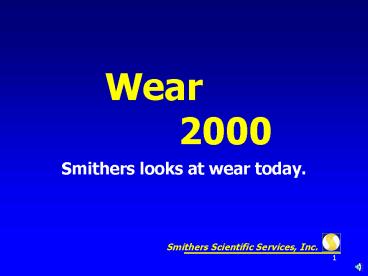Wear 2000 - PowerPoint PPT Presentation
1 / 16
Title: Wear 2000
1
Wear 2000
- Smithers looks at wear today.
2
Tire wear characterization is rapidly changing.
- Wear characterization began almost a century ago
with outdoor fleet tests. - Since 1995 indoor wear testing has become very
important. - In 2000 the change from testing to prediction is
beginning.
3
Outdoor fleet test is classical.
Good Features
Bad Features
- REAL
- WEAR RATE DEFINED
- UNEVEN WEAR VISUALIZED
- THE FINAL CHECK
- SLOW COSTLY
- HARD TO CONTROL REPRODUCIBLY
- DATA FOR ONLY 1 VEHICLE MODEL ON 1 ROUTE
- NO TECHNICAL EXPLANATION OF THE RESULT
- TEST RUINS TEST TIRES
4
Indoor test cuts development time.
Why
- QUICKER
- CHEAPER
- CONTROLLABLE
- UNEVEN WEAR VISUALIZED
STILL - 1 TIRE on 1 ROUTE - NO TECHNICAL
EXPLANATION . OF THE RESULT - TEST
RUINS TEST TIRES
MTS Model 860
5
Predict Design - Virtual WearTM
- QUICKER - CHEAPER
- CONTROLLABLE
- WEAR VISUALIZED
- RESULTS EXPLAINED
- 1 TIRE ON MANY ROUTES
- TEST TIRES INTACT
- METHOD REMAINS VALID WHEN FEA REPLACES FOOTPRINT
TESTING
6
VwearTM Block Diagram
2000
200X
Technical Evolution
Experimental Footprint Data
FEA Predicted Footprint Data
Intensity Computation
Intensity Computation
Route Information
Vehicle Information
Route Intensity Model
Route Intensity Model
Wear Prediction
Wear Prediction
7
VwearTM Notes
- The required footprint data is far more than just
contact pressure. - The footprint experiment is at more than one
condition. You cant model handling on the basis
of one test condition. Neither can you model
tire wear on the basis of one test condition. - One footprint experiment is enough to describe
wear on many vehicles and routes.
8
Intensity over the range of use
LEFT
STRAIGHT
99 of driving is within the illustrated range.
RIGHT
9
VwearTM and Multiple Routes
Route 1
10
VwearTM and Multiple Routes
Route 2
11
VwearTM and Multiple Routes
Route 3
12
VwearTM and Multiple Routes
Route 4
13
VwearTM and Multiple Routes
On And On
14
Suspension Alignment Optimization
Trial 2
Trial 1
Trial 3
15
VwearTM is young and developing.
Come. Join us. Help it develop.

